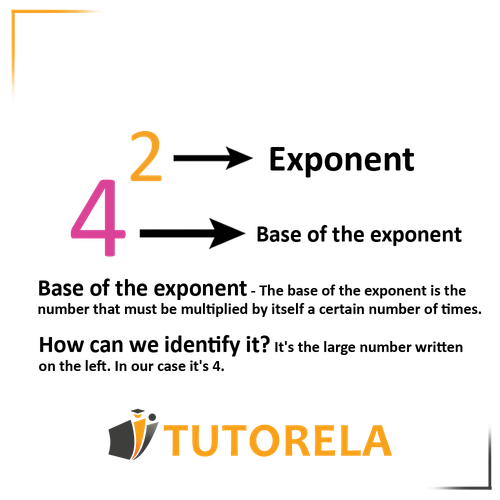An exponent tells us the amount of times a number is to be multiplied by itself.
Powers and Roots Practice Problems - Basic Exponents
Master basic exponents and square roots with step-by-step practice problems. Learn how to solve powers like 4² and roots like √16 with guided exercises.
- Calculate basic exponents like 3², 5³, and identify base and exponent
- Solve square roots including √4, √16, and √25 using inverse operations
- Apply special exponent rules: any number to power 0 equals 1
- Recognize that any number to power 1 equals itself
- Practice mixed problems combining exponents and roots in expressions
- Build confidence with step-by-step solutions and detailed explanations
Understanding Powers and Roots - Basic
Exponents and Roots
What is an exponent?
What is a root?
A root is the inverse operation of exponentiation, which helps us discover which number multiplied by itself gives this result.
The square root is equal to the power of 0.5.

Practice Powers and Roots - Basic
\( \sqrt{16}= \)
Examples with solutions for Powers and Roots - Basic
Choose the expression that is equal to the following:
To solve this problem, we'll focus on expressing the power as a series of multiplications.
- Step 1: Identify the given power expression .
- Step 2: Convert into a product of repeated multiplication. This involves writing 2 multiplied by itself for a total of 7 times.
- Step 3: The expanded form of is .
By comparing this expanded form with the provided choices, we see that the correct expression is:
Therefore, the solution to the problem is the expression that matches this expanded multiplication form, which is the choice .
Answer:
Which of the following is equivalent to the expression below?
To solve this problem, we will apply the rule of exponents:
- Any number raised to the power of 1 remains unchanged. Therefore, by the identity property of exponents, .
Given the choices:
- : This is .
- : Simplifying this expression yields 10,000, which is equivalent to .
- : This results in 20,000, not equivalent to .
- : This results in 0, not equivalent to .
Therefore, the correct choice is , which simplifies to 10,000, making it equivalent to .
Thus, the expression is equivalent to:
Answer:
To solve this problem, we'll follow these steps:
- Step 1: Recognize what finding a square root means
- Step 2: List known perfect squares to identify which one results in 64
- Step 3: Verify the square root by calculation
Now, let's work through each step:
Step 1: To find the square root of 64, we seek a number that, when multiplied by itself, equals 64.
Step 2: Consider the sequence of perfect squares: , , , , , , , .
Step 3: We see that . Therefore, the square root of 64 is 8.
Therefore, the solution to this problem is .
Answer:
8
Let's solve the problem step by step:
- Step 1: Understand what the square root means.
- Step 2: Apply this definition to the number .
- Step 3: Determine the correct number.
The square root of a number is a value that, when multiplied by itself, equals . This is written as .
We are looking for a number such that . This translates to finding .
We know that . Therefore, the principal square root of is .
Thus, the solution to the problem is .
Among the given choices, the correct one is: Choice 1: .
Answer:
6
To solve this problem, we'll follow these steps:
- Step 1: Set up the multiplication as .
- Step 2: Compute the product using basic arithmetic.
- Step 3: Compare the result with the provided multiple-choice answers to identify the correct one.
Now, let's work through each step:
Step 1: We begin with the calculation .
Step 2: Perform the multiplication:
- Multiply the units digits: .
- Next, for the tens digits: .
- Add the results: . This doesn't seem right, so let's break it down further.
Let's examine a more structured multiplication method:
Multiply by (last digit of the second 11), we get 11.
Multiply by (tens place of the second 11), we get 110.
If we align correctly and add the partial products:
11
+ 110
------------
121
Step 3: The correct multiplication yields the final result as . Upon reviewing the provided choices, the correct answer is choice 4: .
Therefore, the solution to the problem is .
Answer:
121